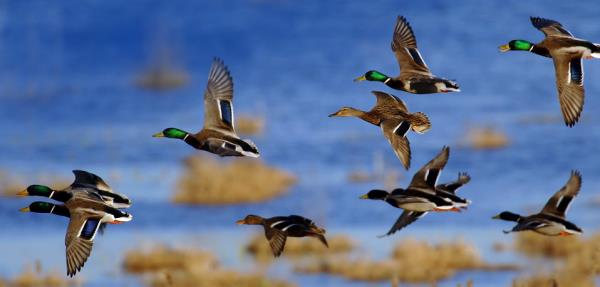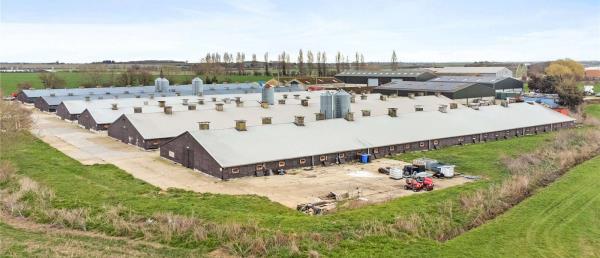INTRODUCTION

This special edition of EGG-NEWS highlights the contribution of the AVIX Autonomic Mark II laser wild-bird repellant system to preventing highly pathogenic avian influenza (HPAI). The technology was developed in Holland to discourage wild birds from damaging fruit and row crops. Since introduction, AVIX laser installations have been extended to protect poultry and dairy farms solar arrays, golf courses and electric substations. Bird Control Group claim close to 4,000 users in 110 nations and their product has received a wide range of awards based on innovation and effectiveness.
HPAI IS TRANSMITTED FROM WILD BIRDS BY THE AEROGENOUS ROUTE
It is now an established reality that migratory waterfowl carry and disseminate highly pathogenic avian influenza virus. In addition, there is confirmation that domestic non-migratory bird species are susceptible to H5N1 HPAI and are involved in persistence and spread of infection. This is evidenced by incident outbreaks in backyard flocks that effectively serve as sentinels. Weekly USDA reports on cases confirm that during March, outbreaks were recorded from California eastward to Vermont and from Minnesota south to Texas confirming that endemic HPAI is potentially present in all states and is no longer confined to seasonal migration of waterfowl.
Preliminary epidemiologic studies by APHIS identified proximity of farms to concentrations of wild birds as a significant risk factor in outbreaks of HPAI. Since 2022, anecdotal and preliminary field evidence suggested that avian influenza virus may be transmitted over distances of up to a mile if a virus is entrained on dust and dander by high winds. Avian influenza virus remains viable on moist soil for periods exceeding a week. The presence of waterfowl in the vicinity of large egg production complexes along the Mississippi and Pacific flyways is well established. Migratory waterfowl are attracted to wetlands, open water and in some cases effluent and water retention ponds in the vicinity of farms. In an recent evaluation of the standard of biosecurity on a complex in a Midwest state, seagulls were observed perching on the ridges of houses and Canada geese ranged within yards of houses feeding on grass.
A recent publication from Tawain confirmed that concentration of migratory birds on wetlands excrete avian influenza virus detected by air sampling. In a study conducted between October 2017 and December 2019, 357 ambient air samples were collected and analyzed using rtPCR assay. Avian influenza strain H7 was detected in 12 percent of air samples and H5 was indentified in 8 percent of samples. The frequency of isolation related to ambient temperature and the concentration of migratory birds including teal, widgeons, spoonbills and cormorants (Zhang 2022).
 |
A second study conducted by the Wageningen Bioveterinary Research Institute confirmed that DNA from waterfowl could be detected in the incoming air stream of poultry houses that had been depopulated and decontaminated following outbreaks. The area in which the study was conducted was known to have a high population of migratory and resident waterfowl and a history of H5N1 cases. In the study, houses selected for assay were devoid of flocks and the ventilation systems were operated consistent with the respective requirements of flocks that would have been housed. Air sampling equipment was placed directly in air inlets and parallel samples were obtained from the exterior of sampled houses. In the case of two empty broiler houses waterfowl DNA was identified in one out of five and one out of twenty-one samples respectively. In the case of a single layer house, two out of twenty-one samples were positive. For exterior air samples, waterfowl DNA was isolated from two out of twenty-one samples.

Wageningen Institute |
These studies demonstrated that commercial poultry confined to power-ventilated buildings may be exposed to avian influenza virus since DNA from waterfowl was detected in the airflow at air inlets. In the context of units holding 100,000 laying hens maximum airflow would correspond to 600,000 cfm assuming 1.5 cfm per pound live weight. Air inlet velocities could approach 600 ft/minute at the inlets depending on their collective area and the air displacement rate and number of fans in operation. The introduction of HPAI virus into a large complex is obviously facilitated by the quantum of air introduced into houses under normal operation with environmental variables including temperature, humidity, wind speed and direction, cloud cover and other environmental variables promoting survival of virus together with proximity to concentrations of migratory waterfowl or potentially infected birds.
Aerogenous transmission of Newcastle disease virus was confirmed during the 1972 outbreaks in Essex in the U.K. and there is no reason to reject a parallel mechanism for avian influenza.

Affected U.K. Broiler complex |
Filtration of incoming air to exclude virus and attempts at inactivation are impractical, therefore alternative modalities are required to address this route of possible introduction of HPAI virus. Even the most stringent structural and operational biosecurity directed at fomites introduced on personnel and feed delivery vehicles cannot provide absolute protection as evidenced by outbreaks on complexes with high standards of protection. Repelling wild birds is considered to be a practical and cost-effective measure complementing structural and operational biosecurity. Cannons have proven to be ineffective, installation of screens and wire over lagoons is expensive creating an opportunity for novel approaches including the use of laser technology.
 |
Bosser, A. et al. Detection of airborne wild water bird-derived DNA demonstrates potential for transmission of avian influenza virus via inlets into poultry houses in the Netherlands 2021-2022 Euro Surveill. 2024: 29 doi.org/10.287/1560-7917. ES. 2024.29.40.2400350
Zhang, J. et al. Airborne avian influenza virus in ambient air in the winter habitats of migratory birds. Environ. Sci. Technol. 56-15365-15376 2022